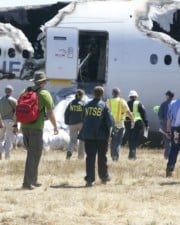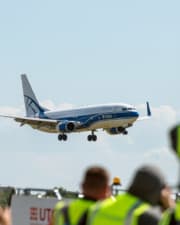Have you ever looked up to the sky to see a message or shape left there by an aircraft? This is known as skywriting and is something of an art form among certain groups of pilots. But what exactly is it?
As the name would imply, skywriting is writing left in the sky. This is done by aircraft using specialized chemicals and careful planning to ensure the letters form to make a word and that they’re large enough to be visible from the ground.
What is Skywriting?
Skywriting is a unique form of aerial advertising or visual communication that involves the creation of large, visible messages or designs in the sky. It is achieved by using a specially designed aircraft equipped with a smoke-emitting system.
The process begins with a pilot flying the skywriting plane to the desired location. Once in position, the pilot activates the smoke-emitting system, which releases a stream of specialized smoke-forming material, typically composed of a paraffin oil mixture.
The material is heated and vaporized, forming a white smoke that is emitted from the aircraft.

As the plane flies through the sky, the pilot carefully maneuvers it to create specific patterns or words. This is achieved by controlling the emission of smoke and precisely timing the movements of the aircraft.
By adjusting the throttle, altitude, and direction, the pilot can shape the emitted smoke into recognizable letters, words, or even shapes.
The smoke lingers in the air for a period of time, allowing people on the ground to see the message or design from a distance.
However, wind conditions and air currents can cause the smoke to disperse and distort the original shape, so the pilot must constantly adjust their flying to maintain clarity and legibility.
What is the Purpose of Skywriting?
There are a number of reasons a pilot might do skywriting. These reasons include:
Advertising
Giving your business branding wings is no longer impossible with skywriting – An extraordinary form of advertising that uses specialized aircrafts for creating attention-grabbing large messages or designs on skies!
Skywriting captivates audiences wasting no time capturing their attention it helps businesses advertise their products/services uniquely.
Skywriting can host company names/logo/key messages in skies creating impressive impressions upon those who witness them leading to increased exposure among a wider audience – making sure that your brand has an edge over others who offer similar services/products.
With such incomparable visibility offered by skywriting over such broad geographic areas such as neighborhoods, parks, stadiums and other public spaces make it easier for your ads to be viewed by many!
Providing those who view these ads with an unforgettable experience creating positive associations with brands witnessing them first-hand would leave ever-lasting impressions upon viewers which have them shared on social media platforms spreading awareness amplifying this innovative way of advertising out even further!
Protesting
Skywriting offers a fresh approach for individuals or groups determined to have their voices heard. With its distinct ability to focus attention on social injustices or particular causes in creative ways, planes bearing strong messages high above us are being utilized by protestors more frequently than ever before.
Creative expression with the intention being one form of impact has long been a hallmark of protests.
The superiority lies in ideas that leave an impression on people who witness demonstrations. Skywriting creates an unforgettable visual experience by inscribing extraordinary words high up whilst simultaneously reaching vast audiences beyond the demonstration area.
Through conquering public airspace protestors demonstrate a profound respect for both themselves and their respective beliefs (or interests). This symbolic act enables causes – initially unnoticed – swiftly relating values with justifiable concepts through aerial artful language – which go beyond slogans or symbols.
Such is the power behind airborne stunts designed for desired reflection by relevant authorities and agencies tasked with making decisions that matter.
Skywriting continually reminds us that the agendas of just causes are subsequently fleeting and therefore always require further constancy in order that the messages are not forgotten.
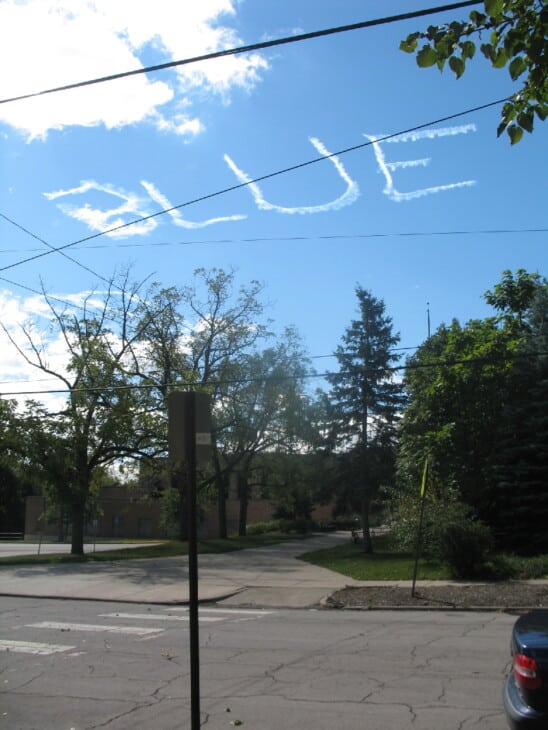
It is a call to action which shuns complacency resulting from solely relying on political engines mechanisms, encouraging activism and awareness at all levels.
Demonstrations taking to the skies through skywriting have stimulated attention to themselves by being unique.
Spectators observing this type of protest whilst also considering what they represent engages an unhindered curiosity. This method is creating discussions amongst people outside of (but supportive towards) the protest as can be seen by their related social media posts.
The fact that skywriting as a mode of demonstration has become so popular among advocates seeking to send a message indicates clearly how important it needs to be for them to create innovative means in achieving their goals regardless of the level of its potency.
Personal Messages
If you want your important celebration to have an added touch of grandeur or spectacle – look no further than skywriting!
This artistic practice provides an unforgettable way of commemorating crucial occasions such as weddings, engagements, anniversaries or even personalized birthday celebrations- which are becoming increasingly popular among couples too!
Just imagine how exciting and surprising it would be when a plane glides gracefully overhead leaving behind white smoke spelling out ‘Will you marry me?” to get the rest of your life (hopefully) started! Skywriting is all about creating moments that people will never forget.
Also noteworthy is its ability to draw wide attention when used for public announcements or advertisements thanks largely due its incredible display in the skies.
Memorials And Tributes
Skywriting is a powerful tool for expressing respect and remembrance in memorial and tribute messages. It can serve as a heartfelt way to honor loved ones during times of loss or commemoration with collective unity.
When it comes to memorials specifically, skywriting proves as an exceptional gesture to pay homage gracefully while symbolizing it on grander grounds than any other means possible – writing names in the skies for their memory’s public display.
It creates moments of reflection that touch everyone who caught sight of them; friends/family/community alike all remember together dearly.
Besides memorials themselves, one can also use this medium for writings that commemorate big dates/events or celebrate influential figures’ lives equally effectively.
How is Skywriting Done?
Creating messages in the sky through skywriting requires much more than just flying an airplane!
It requires a specially equipped aircraft capable of emitting precise amounts of smoke from oil or paraffin-based chemicals at considerable altitudes above ground level – typically around 10 to 15 thousand feet high.
A skilled pilot coordinates various maneuvers such as turns, climbs and descents to form stunningly sharp lines that create legible letters/shapes onlookers can read from below.
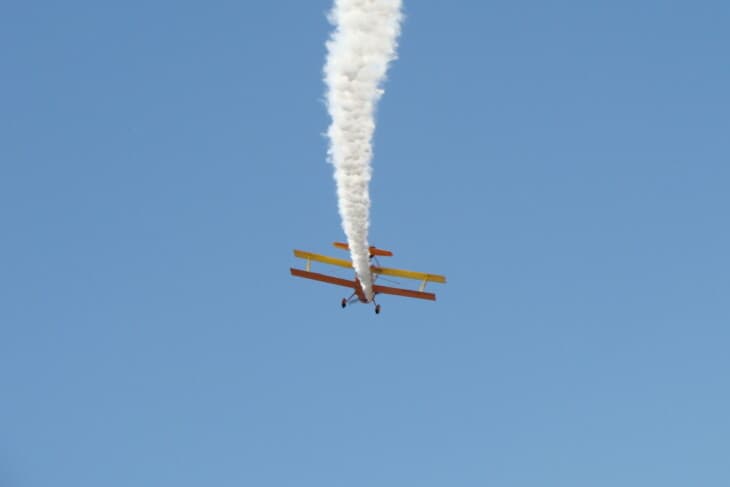
Is Skywriting Legal in The US?
Absolutely! The United States legally allows for this activity but follows specific legislation and guidelines subject to the oversight of the Federal Aviation Administration (FAA) that manages airspace plus regulates aerial events like skywriting performances.
Aerial advertising through this form should stick to precise guidelines ensuring flight safety rules while avoiding interference with other aircraft present in airspace at that time.
Pilots executing skywritten flights should be aware of these restrictions plus also possess necessary certifications along with permits imposing additional limitations available under municipal or state-level jurisdiction unique to each locale where such public performances occur; compliance is mandatory for everyone involved.
It should be noted that skywriting isn’t legal everywhere. In many countries, skywriting is illegal, while in others it is heavily regulated. Other countries, like the UK, have recently legalized it, putting in something of a limbo, as it is only partially regulated.
Is Skywriting bad for the Environment?
Regardless of how much we may love aviation, there’s no denying that it is immensely polluting. In recent years, studies have been conducted to measure the environmental impact of different aviation activities including skywriting.
What they discovered was that skywriting as a whole produces roughly three tons of CO2 per year. To put that in perspective, that’s about the same annual CO2 production as a small house in most countries.
So no, skywriting isn’t particularly harmful to the environment. You could probably say its environmental impact is minimal relative to the millions of tons of CO2 produced each year by the aviation industry worldwide.
How Long Does Skywriting Last?
Perhaps the most endearing quality of skywriting is just how it’s not permanent. All in all, it can last anywhere from three or four minutes to an hour.
The reason for these differing lengths of time is primarily due to conditions and the style of skywriting employed.
On days that have high winds and/or poor visibility, skywriting messages can become illegible quite quickly as the wind blows the smoke away or factors like clouds block part of or all the message.
Especially on windy days, the start can sometimes disappear before the message has been finished if the message is long enough. This is why most skywriters choose not to fly on days with low visibility and/or high winds.
However, the reverse is also true. On days with little to no wind and great visibility, skywriting can last up to an hour before wind blows the message away.
How Far Away Can You See Skywriting?
Being typed into the sky, skywriting has the distinct advantage of allowing people to see it from up to 30 miles (48 kilometers) away.
This number, however, is based on the average size of the letters (875 yards/800 meters tall by 655 yards/600 meters wide).
If a pilot were to increase the height and width of their letters accordingly, and thus the size of their message, there is every possibility that it could be seen from up to 50 miles (80 kilometers) away.
Doing this, however, is quite rare due to the increased difficulty of performing such a stunt and the fact that by the time the message is finished, not all of it will still be readable.
What is the Difference Between Skywriting and Skytyping?
Even though both practices fall under aerial advertising, they differ according to their process.
Skywriting requires one plane to release substantial amounts of smoke following a precise path as directed by its pilot, resulting in letters, words or shapes all perfectly legible up high; however after some time, this message fades away along with its effectivity.
Meanwhile, skytyping encompasses several aircraft moving uniformly with each producing brief puffs of smoke at specific intervals – accomplishing coordinated actions that generate snazzy dots converting into notices easy to read amongst more intricate messages visible from afar lasting an extended period.
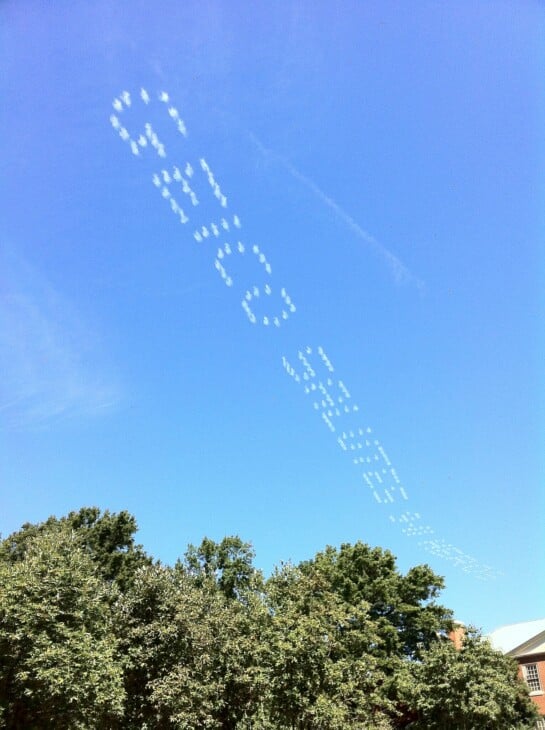
Can You Do Skywriting at Night?
Skywriting is a visually striking artistic approach that depends on favorable weather conditions to make it truly exceptional. Unfortunately, there are limitations when considering the suitability of nighttime as an option for this spectacle of communication.
Low light denotes compromised visibility and prohibits messages from being visible as smoke trails need ample natural light.
Daylight hours are preferable when working with skywriting because of the saturation lent by natural light in order to create optimal visibility between smoke trails and flat blue skies.
To achieve peerless visual effects by the audience, non-overcast clear skies with high on-ground visibility must coincide during execution periods.
Generating smoke trails in low light artificially may seem like a practical substitute, but would result in diminished clarity and lower viewing satisfaction compared to daytime occurrences where natural illumination enlivens aesthetics connected with appearances.
What Planes Do Skywriters Use?
The art of skywriting owes much to state-of-the-art airplanes known as skywriters or skytypers; specifically designed to create legendary contrasts against pure blue skies by emitting vast plumes of scented oils behind them – visible from miles out despite their apparent altitude.
Common skywriter planes include:
- Grumman G-164 Ag-Cat
- North American SNJ
- North American T-6 Texan
The Grumman G-164 Ag-Cat takes its place among this select group as one such plane recognized globally by enthusiasts worldwide because of its unique versatility; initially devised for crop dusting before morphing into a purpose-built craft perfect both for maneuvering through the sky and creating intricate messages with smoke trails.
North American SNJs or T-6 Texans are other military planes modified to churn out sturdy graphics into the air.
Akin to the Grumman, each has undergone modifications making them perfect for typograffiti arts as newer, tech-savvy ways of expression on a grand scale.
Boasting enhanced capabilities that make them more agile during aerial maneuvers than their peers, these models remain a joy to operate and are spotted at rallies in support of causes or brands. These three types of aircraft stand out as unique selections within an ever-growing international fleet.
The aforementioned craft possess specialized systems affixed with devices that release a mixture called paraffin oils or oil-based products directly into exhaust stacks creating visible smoke or vapor trails in seconds – while enabling versatile movements by expert pilots that have mastered how to manipulate such crafts at different angles successfully.
As with any tool, though, one might see new entrants come onto the scene in time – but for now – these dependable planes link their reputation to being amongst the best skywriting options available today.
Related Posts






